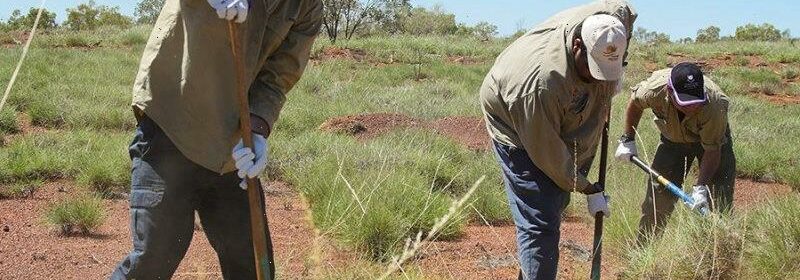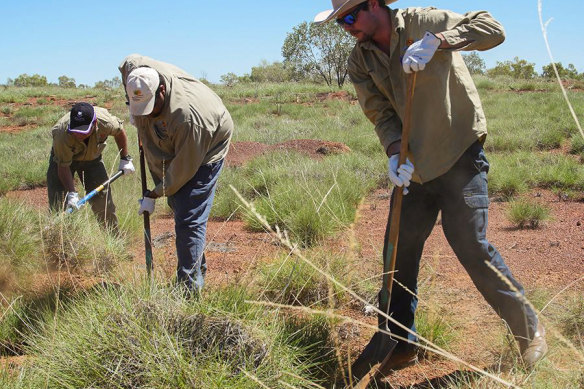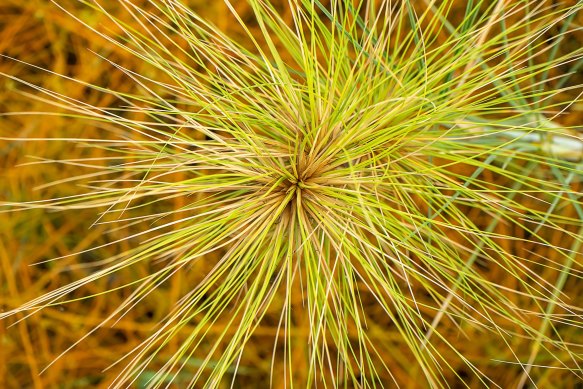Indigenous science in spotlight as desert grass leads to medical gel breakthrough

Few plants are hardy enough to survive the red desert plains of central Australia, where the sands can reach 50 degrees and rain evaporates as soon as it falls. But one does more than just survive – spinifex thrives.
The grass is thin, strong and barely needs any rain. Its remarkable properties have long been known to local First Nations communities, who have used the grass to make shelters and beds and its plastic-like resin as glue for spear points for thousands of years.
About 15 years ago, scientists from the University of Queensland trekked out to these communities to study the grass.
Spinifex displays extraordinary strength, thanks to its unique cellulose nanofibres.
Under the microscope, spinifex revealed its secret: a unique arrangement of hair-like cellulose nanofibres, which result in an extraordinary tensile strength five-times that of stainless steel.
The scientists and the locals created Trioda Wilingi, a majority Indigenous-owned company that is in the final stages of developing medical gels – a possible treatment for osteoarthritis – from the nanofibres.
Science Minister Ed Husic has signalled he wants to promote these sorts of projects. Last week, he launched a review of the nation’s science priorities, which set the long-term vision for Australian science. He has already recommended First Nations science become a key priority.
”He wants to go past lip service,” a source close to the minister said.
The minister has also quietly set First Nations science as a priority for the CSIRO.
“Our First Nations peoples were our first scientists and must play an enduring and central role in our scientific endeavours,” he wrote in a letter to the organisation.
Husic did not respond to a request for comment by deadline.
Spinifex’s remarkable properties have long been known to local First Nations communities, who use the grass to make shelters and beds, and its plastic-like resin as glue for spear-points.
As Western and First Nations science come closer together, the hope is that more discoveries like the spinifex nanofibres will occur.
“We used to have a supermarket, Indigenous people,” says Colin Saltmere, an Indjalandji-Dhidhanu man and the director of Trioda Wilingi. “There’s not just spinifex out there, there’s all sorts of things – animals that produce medical things, insects, ants.”
The Indjalandji-Dhidhanu people harvest the spinifex on their native-title lands, only taking the top of the plant and leaving the roots in place, which keeps the ecosystem safe, says Saltmere. The spinifex is then processed into nanofibres with the help of the Australian National Fabrication Facility.
Over its history, modern science has been dominated by white, Western thinkers: from Aristotle and the Enlightenment to today’s science workforce that remains largely made up of white men.
First Nations science recognises the value of knowledge built up in Indigenous communities over tens of thousands of years.
“We were doing science way before science was a thing,” says Bradley Moggridge, an associate professor in Indigenous water science at the University of Canberra.
“Every part of the landscape, Aboriginal people have touched, have experimented on. Look at bush foods and bush medicines. Look at engineering – fish traps, weirs, dams.”
But Western science has long excluded and looked down on other forms of knowledge.
“I can’t reference my ancestors because there is no physical literature,” Moggridge says.
Moggridge’s research identifies Indigenous knowledge that can point to places in the landscape that once had water but have now been cut off by changes in irrigation practices. By bringing the water back, the land can flourish.
Several researchers are exploring First Nations astronomy. Many records of eclipses, comets, supernovas and meteors are contained within Indigenous knowledge, often passed down through oral histories – records that have been entirely ignored by Western science.
“Western science has not really opened itself up to other forms of information-keeping and observations,” says Karlie Noon, an Indigenous research associate at the Australian National University’s School of Astronomy and Astrophysics.
Progress has not been without controversy. In New Zealand, seven professors signed a letter criticising school plans to teach Maori knowledge. “Indigenous knowledge … falls far short of what we can define as science,” they wrote.
Noon says the dominance of Western science has promoted a mindset of extracting resources from the natural world. First Nations science promotes viewing humans and their environment as one.
“It’s not about ownership – it’s about custodianship,” she says. “The knowledge provides custodians with the best information required to look after that place.”
Liam Mannix’s Examine newsletter explains and analyses science with a rigorous focus on the evidence. Sign up to get it each week.
Most Viewed in National
From our partners
Source: Read Full Article

